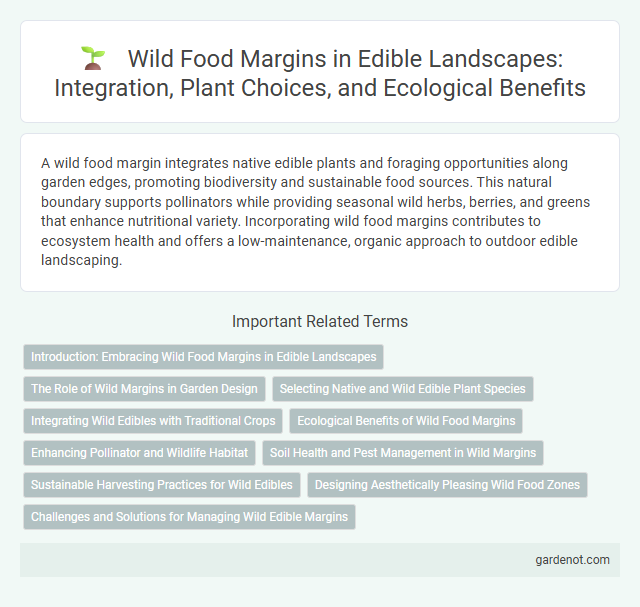A wild food margin integrates native edible plants and foraging opportunities along garden edges, promoting biodiversity and sustainable food sources. This natural boundary supports pollinators while providing seasonal wild herbs, berries, and greens that enhance nutritional variety. Incorporating wild food margins contributes to ecosystem health and offers a low-maintenance, organic approach to outdoor edible landscaping.
Introduction: Embracing Wild Food Margins in Edible Landscapes
Wild food margins integrate diverse native plants along garden edges, enhancing biodiversity and providing nutrient-rich foraging options. These fringes support pollinators and beneficial insects, creating a balanced ecosystem while producing wild edibles like berries, herbs, and greens. Incorporating wild food margins into edible landscapes fosters sustainable food sources and strengthens ecological resilience.
The Role of Wild Margins in Garden Design
Wild food margins play a crucial role in garden design by enhancing biodiversity and promoting sustainable food production. These natural borders provide habitats for pollinators and beneficial insects while yielding edible plants such as wild herbs, berries, and greens. Integrating wild margins supports ecological balance and offers an abundant, low-maintenance source of nutrient-rich foraged foods.
Selecting Native and Wild Edible Plant Species
Selecting native and wild edible plant species for a wild food margin enhances biodiversity and supports local ecosystems. Prioritize plants such as wild garlic (Allium ursinum), dandelion (Taraxacum officinale), and chickweed (Stellaria media), which are well-adapted to regional soil and climate conditions. These species provide nutritious, sustainable foraging options while attracting beneficial pollinators and enriching soil health.
Integrating Wild Edibles with Traditional Crops
Wild food margins enhance biodiversity by providing habitats for native plants and animals alongside traditional crops. Integrating wild edibles such as purslane, dandelion, and wild garlic into these margins promotes natural pest control and supports pollinators crucial for crop yields. This practice improves soil health and creates a resilient agroecosystem that increases food diversity and ecosystem services.
Ecological Benefits of Wild Food Margins
Wild food margins enhance biodiversity by providing habitats for pollinators, insects, and small mammals, which support ecosystem stability and crop pollination. These buffer zones improve soil health through organic matter accumulation and reduce erosion, promoting sustainable land management. Furthermore, wild food margins contribute to natural pest control by harboring predatory species that mitigate agricultural pest populations.
Enhancing Pollinator and Wildlife Habitat
Wild food margins significantly enhance pollinator and wildlife habitats by providing diverse native plants that offer nectar, pollen, and shelter critical for bees, butterflies, and other beneficial insects. Integrating wild food margins into edible landscapes supports biodiversity, improves ecosystem resilience, and promotes natural pest control by attracting predatory species. These habitats contribute to healthier soil and increased crop yields by fostering a balanced and sustainable environment.
Soil Health and Pest Management in Wild Margins
Wild food margins enhance soil health by increasing organic matter and supporting beneficial microbial communities that improve nutrient cycling and soil structure. These margins act as natural pest management zones by providing habitats for predators and pollinators, reducing the need for chemical pesticides. Integrating diverse wild plants in food margins fosters resilient ecosystems that sustain both crop productivity and biodiversity.
Sustainable Harvesting Practices for Wild Edibles
Sustainable harvesting practices for wild edibles in edible landscapes emphasize careful selection and minimal impact on natural habitats to preserve biodiversity. Techniques such as rotational harvesting, using hand tools, and avoiding overharvesting ensure the long-term availability of wild food margins. Adhering to legal regulations and local guidelines supports ecosystem health while providing nutrient-rich, foraged ingredients.
Designing Aesthetically Pleasing Wild Food Zones
Creating aesthetically pleasing wild food zones involves integrating diverse native plants that provide edible fruits, nuts, and herbs while enhancing visual appeal through varied textures, colors, and seasonal interest. Incorporating naturalistic planting patterns and maintaining habitat corridors supports biodiversity, pollinators, and soil health, making wild food margins both productive and ecologically sustainable. Strategic placement near pathways and social areas ensures easy access and encourages foraging, blending functionality with landscape beauty.
Challenges and Solutions for Managing Wild Edible Margins
Wild food margins face challenges such as invasive species overgrowth, soil degradation, and inconsistent foraging yields that threaten biodiversity and food security. Implementing targeted native plant restoration, soil enrichment techniques, and community-led monitoring programs enhances ecosystem resilience and sustainable harvests. Integrating adaptive management practices with local knowledge ensures balanced productivity and conservation of wild edible margins.
Wild food margin Infographic

 gardenot.com
gardenot.com